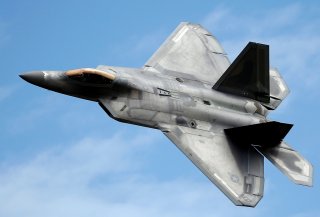The F-22 Raptor Could Be Just What Navy Aircraft Carriers Need
During the U.S. Navy’s Valiant Shield exercise in the Pacific in September, the service began to explore the idea of having F-22 Raptors defend surface ships such as destroyers, amphibious assault ships and carriers.
Here's What You Need to Remember: Such a prospect presents interesting options, should an F-22 be able to reach the right ranges and be sufficient to conduct missions overhead. Refueling an F-22 with the Navy’s emerging MQ-25 Stingray carrier-launched drone refueler, however, might extend dwell time and mission scope in a significant fashion.
Should an entire U.S. Navy Carrier Strike Group finds itself in a great power war on the open ocean, it seems possible that surface ships might struggle to defend against attacks from enemy fifth-generation stealth fighters. Unless, that is, large numbers of carrier-launched F-35Cs were operational and able to engage in air-to-air combat against approaching enemy aircraft.
But how about F-22 stealth fighter jets? During the U.S. Navy’s Valiant Shield exercise in the Pacific in September, the service began to explore the idea of having F-22 Raptors defend surface ships such as destroyers, amphibious assault ships and carriers.
Perhaps the stealth fighter, believed by many to be the most dominant and advanced air-superiority platform in existence, could defend carriers? Why not?
Speaking of carriers, Retired Lt. Gen. David Deptula, Dean of the Mitchell Institute for Aerospace Studies, makes the point that damage to surface ships such as carriers in open-ocean warfare can bring catastrophic effects.
“You can’t sink land-bases. They can be rapidly reconstituted. Carriers present a huge footprint that is potentially more vulnerable...but is that the best use of an F-22?” Deptula said.
Given that the F-22 program was, in the minds of many, prematurely truncated years ago, there may not be sufficient numbers of available F-22s for a mission of this kind. More importantly, would they have the reach and staying power to preserve vulnerable air space above surface ships? It seems availability, and the number of nearby F-35Cs, might also be pertinent factors.
For the first time, the joint Valiant Shield exercise included an Army unit focused on Multi-Domain Operations and the event tested air-ground-sea networking technologies merging Navy ships, Poseidon spy planes and even mine warfare capable B-52s to conduct integrated operations.
Broadly speaking, a Navy report referred to the mission scope as “maritime security operations, anti-submarine and air-defense exercises, amphibious operations, and other elements of complex warfighting.”
Carrier strike groups are of course known for their many defenses such as air-and-missile defense interceptors, long-range guns and close-in-defenses such as Phalanx guns or anti-torpedo technologies. Could ship self-defense systems, which increasingly include weapons such as lasers and electronic warfare systems, be better served by having F-22s operate overhead?
Such a prospect presents interesting options, should an F-22 be able to reach the right ranges and be sufficient to conduct missions overhead. Refueling an F-22 with the Navy’s emerging MQ-25 Stingray carrier-launched drone refueler, however, might extend dwell time and mission scope in a significant fashion. Existing ship defenses may be well equipped to defend against anti-ship missiles, enemy boats and even ballistic missiles, yet it does seem apparent that they could be vulnerable to fifth-generation enemy aircraft. Clearly these threat circumstances are why the Pentagon developed the F-35, yet they also raise the question as to whether an air-to-air dominant fighter like an F-22 might also be well suited to preserve air security in ocean warfare.
Certainly the advent of Russian and Chinese fifth-generation stealth aircraft changed the threat equation in a substantial way, regarding the kinds of attacks possibly faced by surface ships. China, for instance, is fast-tracking a carrier-launched variant of its J-31 to rival the F-35B.
“F-18s are not going to bring much utility in a high-end fight,” Deptula said.
Kris Osborn is the defense editor for the National Interest. Osborn previously served at the Pentagon as a Highly Qualified Expert with the Office of the Assistant Secretary of the Army—Acquisition, Logistics & Technology. Osborn has also worked as an anchor and on-air military specialist at national TV networks. He has appeared as a guest military expert on Fox News, MSNBC, The Military Channel, and The History Channel. He also has a Masters Degree in Comparative Literature from Columbia University. This first appeared last year and is being reposted due to reader interest.
Image: Reuters

